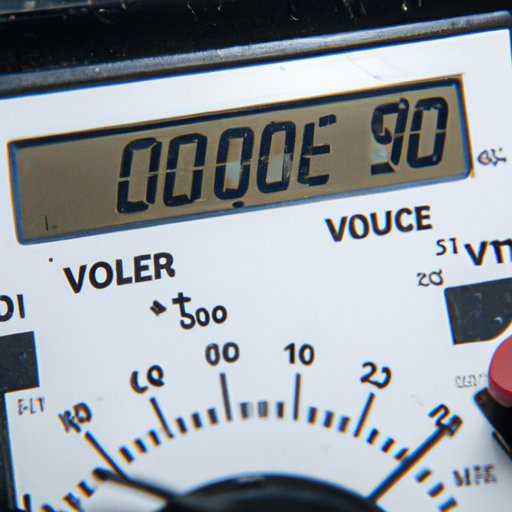
I. Introduction
Many electrical devices, from small-scale electronics to complex machinery, require an accurate measurement of voltage for optimal performance. This is where a voltmeter comes into play. A voltmeter is an electronic device used to measure voltage levels in circuits. It is an essential tool for electricians, hobbyists, and anyone who needs to work with electrical systems. In this article, we’ll explore everything you need to know about using a voltmeter effectively and safely.
II. How to Use a Digital Voltmeter
A digital voltmeter is a type of voltmeter that provides a numerical reading of the voltage level. It is typically more accurate and easier to use than an analog voltmeter. To use a digital voltmeter, follow these simple steps:
- Connect the voltmeter’s probes to the circuit being measured. The red probe should be connected to the positive side, and the black probe should be connected to the negative side of the circuit.
- Set the range selector to a suitable range for the voltage level to be measured. This can be done automatically or manually.
- Read the numerical voltage value displayed on the voltmeter’s digital display.
While digital voltmeters are straightforward to use, there are some important things to watch out for. When using a digital voltmeter, ensure the probes are correctly and securely attached to avoid misreading or electrical shock. Also, be cautious of the polarity of the probes, as reversing them may cause damage to the circuit or the voltmeter itself.

III. Importance of Safety Measures While Using a Voltmeter
Working with electricity can be particularly dangerous. It is essential to prioritize safety when using a voltmeter to avoid injury or property damage. Here are some safety measures to take when using a voltmeter:
- Ensure the voltmeter is properly calibrated and in good working condition.
- Wear appropriate protective gear, such as safety glasses and insulated gloves.
- Ensure the circuit being measured is turned off before attaching the probes.
- Never touch the probes with your bare hands when they are attached to the voltage source and the voltmeter.
Ignoring safety measures can result in severe consequences, including electric shock, fire, or even death. Always put safety first when handling electrical devices.
IV. Common Mistakes to Avoid While Taking Voltage Reading with a Voltmeter
While using a voltmeter, some common mistakes can lead to inaccurate readings and even pose a risk to the user’s safety. These mistakes include:
- Not using the correct range setting for the voltage level being measured.
- Measuring voltage in a circuit that is still active.
- Reversing the polarity of the probes while measuring voltage.
- Touching the probes with your bare hands or allowing them to touch each other.
To avoid these mistakes, always read and follow the instructions in the voltmeter manual carefully. Double-check the connections before measuring voltage. Don’t forget to wear appropriate safety gear and ensure the circuit is turned off before measuring voltage. Remember, accuracy and safety go hand in hand.
V. Advantages and Disadvantages of Using an Analog Voltmeter
An analog voltmeter works differently from the digital ones as it provides voltage readings by means of a pointer on a scale. It is typically less precise than digital voltmeter and can be challenging to read. Despite these drawbacks, analog voltmeters still have their advantages. Some of the pros and cons of using analog voltmeters include:
- Advantages:
- They require no batteries or power source.
- They offer a continuous reading of voltage levels and fluctuations, making them better for visual interpretation.
- They are relatively straightforward to use, especially for casual users.
- Disadvantages:
- They are typically less accurate than digital voltmeters.
- They require a higher range of expertise and careful reading of the scale.
- They can be challenging to read in low light conditions.
VI. How to Read Voltage Value on a Voltmeter
Here are the steps to follow to properly read voltage values on a voltmeter:
- Ensure the probes are correctly attached to the circuit to be measured.
- Select the range to be measured, depending on the voltage level expected in the circuit.
- Read the voltage value from the numerical display or the scale on the voltmeter.
It is important to watch out for common signs that indicate a wrong reading. These signs include readings that fluctuate above and below the expected value, unusual noises from the voltmeter, or a disconnected choice of range or probes. If these signs are noticed, the measurement should be stopped, and the connections checked to ensure that they are correct.
VII. Using a Voltmeter to Troubleshoot Electrical Problems: Tips and Tricks
A voltmeter can be an invaluable tool when troubleshooting electrical problems. Some tips and tricks to use when troubleshooting with a voltmeter include:
- Ensure the circuit power is turned off before performing any measurements.
- Check for continuity by connecting the probes to all parts of the circuit, checking that a complete circuit is present.
- Check for voltage drops between points in the circuit to find any resistances or connection issues.
- Measure the voltage on both sides of a component, such as a fuse, to identify any issues with it.
- Record the readings obtained and compare them with the voltage expectations of the circuit.
These tips help diagnose common electrical issues, such as blown fuses, blown lamps, and circuit shorts, among others. It is essential to follow safety measures while troubleshooting to avoid electrical shock or other injuries.
VIII. Conclusion
A voltmeter is an essential tool for anyone working with electrical devices. It is essential to use it safely and appropriately to obtain accurate readings and prevent injuries or property damage. In summary, this comprehensive guide has explored how to use a voltmeter, the importance of safety measures, common mistakes to avoid, the advantages and disadvantages of analog voltmeters, how to read voltage values, and the use of a voltmeter for troubleshooting electrical problems. Always take the necessary precautions when working with electrical devices, follow the instructions carefully, and use your voltmeter safely and effectively.





